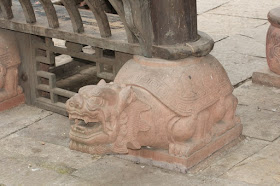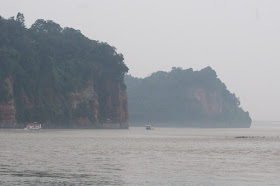The remainder of our Sichuan tour was spent far from anything that resembled a mountain. After our tantalizing glimpse of fabled Mount Emei the night before, our morning attraction was a thoroughly-commercialized and rebuilt "Ancient Town" called Huanglongxi. I took to calling it Disney-Han.
...including an attractive riverside view that you can reach if you bypass the shops and look hard enough.
On the way to the shops from the parking lot I did find a few Oriental Greenfinches (Carduelis sinica) flitting about overhead...
...and, in a patch of undergrowth, this rather plain, if somewhat angular, butterfly. It is either a Common or a Dark Evening Brown (Melanitis leda or M. phedima). The two apparently cannot be distinguished by the underwing pattern alone. Both butterflies have distinct dry-season and wet-season morphs that look far more different from each other than either does from its near relatives. This is a dry-season butterfly; wet-season adults have distinct eyespots on the underside of the wing.
...and, in a patch of undergrowth, this rather plain, if somewhat angular, butterfly. It is either a Common or a Dark Evening Brown (Melanitis leda or M. phedima). The two apparently cannot be distinguished by the underwing pattern alone. Both butterflies have distinct dry-season and wet-season morphs that look far more different from each other than either does from its near relatives. This is a dry-season butterfly; wet-season adults have distinct eyespots on the underside of the wing.
I also found this extremely frustrating little leaf warbler (Phylloscopus sp.). I say frustrating, because it didn't hang around very long, and even these photographs do not give me enough information to be sure which of the multitude of leaf warblers that live in or migrate through Sichuan this one happens to be. If anyone out there can help me I would be very happy indeed!
Whatever the field guides say, these seem to be very common urban birds in the Sichuan lowlands; we saw them almost everywhere (and you'll see them again in future posts).
The flowers planted throughout the village, besides being beautiful in themselves, attracted a few butterflies - nothing rare, but any bit of nature was worth seeing.
This one is a Pea Blue or Long-tailed Blue (Lampides boeticus), a little butterfly that looks far more like a hairstreak of sorts (and indeed I first took it for one). It is in fact one of the most widespread butterflies in the world, ranging from Europe and Africa to Australia and the South Pacific.
This Large Cabbage White (Pieris brassicae nepalensis) is a representative of one of the world's commonest butterflies, carried with our cabbage crops to the far corners of the earth. In Notth America, where it is a widespread exotic, we call it (or at least the European race, the one we have) the Cabbage Butterfly.
The Common Grass Yellow (Eurema hecabe) is another widespread and abundant butterfly, ranging, like the Long-tailed Blue, from Africa across southern Asia to Australia and the South Pacific.
On the way back to the bus I found this spectacular butterfly visiting a bougainvillea bush. It is obviously a swallowtail (though in this case its tails appear to have been nipped off by a hungry bird), but which swallowtail is not so obvious.
In Eastern Asia a complex of large, mostly black swallowtails in the genus Atrophaneura, whose bodies are rendered unpalatable by the toxins they take up, as caterpillars, from their larval food plants (mostly members of the genus Aristolochia), are mimicked, often very closely, by perfectly palatable swallowtails in the genus Papilio. This is one of the mimics, a female Great Mormon (Papilio memnon heronus), the same species I had found only days earlier in Kuching. One clue to its identity as a mimic is its black body (Atrophaneura butterflies tend to be marked with red).
A better clue was the arrival of this almost entirely black, tailless male, who subjected the female to some sexual harassment before deciding to feed on his own. The male is not a mimic (the better to be recognized by potential mates).
A better clue was the arrival of this almost entirely black, tailless male, who subjected the female to some sexual harassment before deciding to feed on his own. The male is not a mimic (the better to be recognized by potential mates).











































































